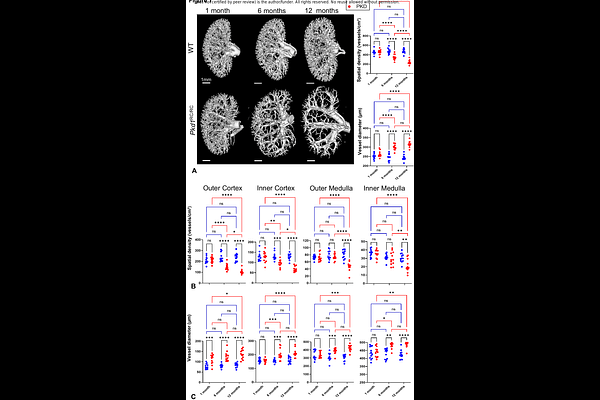Vascular transcriptional and metabolic changes precede progressive intra-renal microvascular rarefaction in autosomal dominant polycystic kidney disease

Vascular transcriptional and metabolic changes precede progressive intra-renal microvascular rarefaction in autosomal dominant polycystic kidney disease
Yilmaz, G.; Singha, S. K.; Savaliya, B.; Abdelfattah, A.; Elsekaily, W.; Xu, X.; Zhang, Y.; Hanna, C.; Hogan, M. C.; Chade, A. R.; Eirin, A.; Irazabal, M. V.
AbstractBackground: The mechanisms contributing to progressive kidney damage in autosomal dominant polycystic kidney disease (ADPKD) remain unclear. Renal microvascular (MV) rarefaction plays an important role in kidney disease, but its natural history, underlying mechanisms, and contributions to renal disease progression in ADPKD remain unknown. We hypothesized that intrarenal MV rarefaction is present early on and is preceded by vascular transcriptional and metabolic changes. Methods: Pkd1RC/RC and WT mice (n=16 each) were studied at 1, 6, and 12 months. Total kidney volume (TKV) was measured in vivo (MRI), whereas renal MV architecture (3DmicroCT), capillary density, perivascular fibrosis, and histomorphometric parameters were assessed ex vivo. In randomly selected Pkd1RC/RC and WT kidneys (n=5, each/timepoint), mRNA sequencing was performed to identify differentially expressed vasculature-related genes (DEGs). Next, in young individuals with ADPKD and matched controls (n=10 each), plasma cellular energy metabolites were determined (LCMS/MS), validated in an extended cohort (n=32 and n=16, respectively), and correlated with markers of disease severity and progression. Gene metabolite interaction networks were generated to integrate DEGs in Pkd1RC/RC at 1 month with metabolites dysregulated in individuals with ADPKD. Results: Renal MV density was preserved at 1 month but progressively decreased at 6 and 12 months, associated with capillary loss and perivascular fibrosis. A total of 110, 48, and 201 DEGs were identified at 1, 6, and 12 months, respectively. Plasma gamma-aminobutyric acid (GABA) and homocysteine (Hcy) levels were higher in individuals with ADPKD versus controls, interacted with DEGs implicated in inflammatory and innate immune response and Hcy metabolism, and correlated with TKV and renal blood flow. Conclusions: Our data demonstrates that intrarenal MV abnormalities present early in ADPKD and are preceded by vascular transcriptional and metabolic changes. The renal microcirculation may constitute an important therapeutic target in ADPKD, and its underlying biomarkers may serve to monitor its progression.